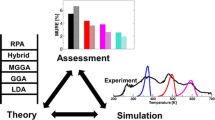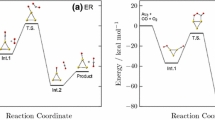Abstract
Hydrogenation reactions catalyzed by transition-metal-containing nanoparticles represent an important type of reaction in chemical industry. However, the modeling of these reactions in their working conditions requires much longer simulation times than what could usually be achieved with ab initio or first-principle methods. To address this problem, in this work, the density-functional-based tight-binding (DFTB) method was parameterized for hydrogenation reactions on molybdenum carbide catalysts, involving the elements C, H, Mo, O and Si. The overall quality of the DFTB parameters was tested with band structure/molecular orbital energies, molecular/crystal structures, chemisorption bond strengths, hydrogen adsorption energies, hydrogenation reaction energies, molecular vibrational frequencies, energy barriers and the structures of the transition states for systems of interest. The parameterized DFTB method gave errors of <1.45 % for bond distances of hydrocarbons and 4.86 % for non-hydrocarbons. It could reproduce the structure and vibrational frequencies (with errors of about 100 cm−1) of selected hydrocarbon–molybdenum carbide complexes obtained from DFT calculations. Good agreement was reached between DFTB and DFT on the dissociative adsorption of hydrogen on the α-Mo2C (0001) surface. For most of the hydrogenation reactions examined, DFTB showed errors of ~2 kcal/mol compared to DFT/PBE, with a few exceptions of ~5 kcal/mol. It could also describe the reaction energies, the forward and reverse energy barriers and the transition-state structures for the benzene hydrogenation reaction on a Mo38C19 cluster.







Similar content being viewed by others


References
Lee JS, Yeom MH, Park KY, Nam I-S, Chung JS, Kim YG, Moon SH (1991) Preparation and benzene hydrogenation activity of supported molybdenum carbide catalysts. J Catal 128(1):126–136. doi:10.1016/0021-9517(91)90072-c
Ardakani SJ, Smith KJ (2011) A comparative study of ring opening of naphthalene, tetralin and decalin over Mo2C/HY and Pd/HY catalysts. Appl Catal A Gen 403(1–2):36–47. doi:10.1016/j.apcata.2011.06.013
Saito M, Anderson RB (1980) The activity of several molybdenum compounds for the methanation of CO. J Catal 63(2):438–446. doi:10.1016/0021-9517(80)90098-6
Kojima R, K-i A (2001) Molybdenum nitride and carbide catalysts for ammonia synthesis. Appl Catal A Gen 219(1–2):141–147. doi:10.1016/S0926-860X(01)00676-7
Liu P, Rodriguez JA (2006) Water-gas-shift reaction on molybdenum carbide surfaces: essential role of the oxycarbide. J Phys Chem B 110(39):19418–19425. doi:10.1021/jp0621629
Du J, Wu J, Guo T, Zhao R, Li J (2014) Catalytic performance of Mo2C supported on onion-like carbon for dehydrogenation of cyclohexane. RSC Adv. doi:10.1039/c4ra08238a
Ledoux MJ, Pham-Huu C, Dunlop H, Guille J (1993) n-Hexane isomerization on high specific surface Mo2C activated by an oxidative treatment. In: Guczi L, Solymosi F, Tétenyi P (eds) Studies in surface science and catalysis, vol 75. Elsevier, Amsterdam, pp 955–967. doi:10.1016/S0167-2991(08)64425-0
Lin SSY, Thomson WJ, Hagensen TJ, Ha SY (2007) Steam reforming of methanol using supported Mo2C catalysts. Appl Catal A Gen 318:121–127. doi:10.1016/j.apcata.2006.10.054
Frauwallner ML, Lopez-Linares F, Lara-Romero J, Scott CE, Ali V, Hernandez E, Pereira-Almao P (2011) Toluene hydrogenation at low temperature using a molybdenum carbide catalyst. Appl Catal A Gen 394(1–2):62–70. doi:10.1016/j.apcata.2010.12.024
Pereira-Almao P (2012) In situ upgrading of bitumen and heavy oils via nanocatalysis. Can J Chem Eng 90(2):320–329. doi:10.1002/cjce.21646
Cui Q, Elstner M (2014) Density functional tight binding: values of semi-empirical methods in an ab initio era. Phys Chem Chem Phys 16(28):14368–14377. doi:10.1039/c4cp00908h
Hopkins JB, Langridge-Smith PRR, Morse MD, Smalley RE (1983) Supersonic metal cluster beams of refractory metals: spectral investigations of ultracold Mo2. J Chem Phys 78(4):1627–1637. doi:10.1063/1.444961
Kent PRC, Hood RQ, Williamson AJ, Needs RJ, Foulkes WMC, Rajagopal G (1999) Finite-size errors in quantum many-body simulations of extended systems. Phys Rev B 59(3):1917–1929. doi:10.1103/PhysRevB.59.1917
Liu X, Tkalych A, Zhou B, Köster AM, Salahub DR (2013) Adsorption of hexacyclic C6H6, C6H8, C6H10, and C6H12 on a Mo-terminated α-Mo2C (0001) surface. J Phys Chem C 117(14):7069–7080. doi:10.1021/jp312204u
Oliveira AF, Seifert G, Heine T, Duarte HA (2009) Density-functional based tight-binding: an approximate DFT method. J Braz Chem Soc 20:1193–1205. doi:10.1590/S0103-50532009000700002
Porezag D, Frauenheim T, Köhler T, Seifert G, Kaschner R (1995) Construction of tight-binding-like potentials on the basis of density-functional theory: application to carbon. Phys Rev B 51(19):12947–12957. doi:10.1103/PhysRevB.51.12947
Ohta Y, Okamoto Y, Irle S, Morokuma K (2008) Temperature dependence of iron-catalyzed continued single-walled carbon nanotube growth rates: density functional tight-binding molecular dynamics simulations. J Phys Chem C 113(1):159–169. doi:10.1021/jp808493f
Witek HA, Morokuma K (2004) Systematic study of vibrational frequencies calculated with the self-consistent charge density functional tight-binding method. J Comput Chem 25(15):1858–1864. doi:10.1002/jcc.20112
Liu X, Salahub DR (2015) Molybdenum carbide nanocatalysts at work in the in situ environment: a density functional tight-binding and quantum mechanical/molecular mechanical study. J Am Chem Soc 137(12):4249–4259. doi:10.1021/jacs.5b01494
Seifert G, Porezag D, Frauenheim T (1996) Calculations of molecules, clusters, and solids with a simplified LCAO-DFT-LDA scheme. Int J Quantum Chem 58(2):185–192. doi:10.1002/(sici)1097-461x(1996)58:2<185::aid-qua7>3.0.co;2-u
Elstner M, Porezag D, Jungnickel G, Elsner J, Haugk M, Frauenheim T, Suhai S, Seifert G (1998) Self-consistent-charge density-functional tight-binding method for simulations of complex materials properties. Phys Rev B 58(11):7260–7268. doi:10.1103/PhysRevB.58.7260
Koskinen P, Mäkinen V (2009) Density-functional tight-binding for beginners. Comput Mater Sci 47(1):237–253. doi:10.1016/j.commatsci.2009.07.013
Slater JC, Koster GF (1954) Simplified LCAO method for the periodic potential problem. Phys Rev 94(6):1498–1524. doi:10.1103/PhysRev.94.1498
Frenzel J, Oliveira AF, Jardillier N, Heine T, Seifert G (2004–2009) Semi-relativistic, selfconsistent charge Slater–Koster tables for density-functional based tight-binding (DFTB) for materials science simulations. TU-Dresden
Wahiduzzaman M, Oliveira AF, Philipsen P, Zhechkov L, van Lenthe E, Witek HA, Heine T (2013) DFTB parameters for the periodic table: part 1. Electronic structure. J Chem Theory Comput 9(9):4006–4017. doi:10.1021/ct4004959
te Velde G, Baerends EJ (1991) Precise density-functional method for periodic structures. Phys Rev B 44(15):7888–7903. doi:10.1103/PhysRevB.44.7888
Köster AM, Geudtner G, Calaminici P, Casida ME, Dominguez VD, Flores-Moreno R, Goursot A, Heine T, Ipatov A, Janetzko F, Del Campo JM, Revelevs JU, Vela A, Zuniga B, Salahub DR (2011) deMon2k. The deMon Developers, CINVESTAV, Mexico
Godbout N, Salahub DR (1992) Optimization of Gaussian-type basis sets for local spin density functional calculations. Part I. Boron through neon, optimization technique and validation. Can J Chem 70(2):560–571. doi:10.1139/v92-079
Lovallo CC, Klobukowski M (2004) Improved model core potentials for the second- and third-row transition metals. J Comput Chem 25(9):1206–1213. doi:10.1002/jcc.20044
Calaminici P, Janetzko F, Koster AM, Mejia-Olvera R, Zuniga-Gutierrez B (2007) Density functional theory optimized basis sets for gradient corrected functionals: 3d transition metal systems. J Chem Phys. doi:10.1063/1.2431643
Blöchl PE (1994) Projector augmented-wave method. Phys Rev B 50(24):17953–17979. doi:10.1103/PhysRevB.50.17953
Heine T, Patchkovskii S, Frenzel J, Köster AM, Calaminici P, Duarte HA, Escalante S, Flores-Moreno R, Goursot A, Reveles JU, Salahub DR, Vela A (2009) The deMon user’s guide, Version deMon-Nano Experiment 2009
Bahn SR, Jacobsen KW (2002) An object-oriented scripting interface to a legacy electronic structure code. Comput Sci Eng 4(3):56–66. doi:10.1109/5992.998641
Program for fitting repulsive potentials, developed in the group of Prof. Gotthard Seifert. http://theory.chm.tu-dresden.de/index.shtml (unpublished)
Abderrahim FZ, Faraoun HI, Ouahrani T (2012) Structure, bonding and stability of semi-carbides M2C and sub-carbides M4C (M = V, Cr, Nb, Mo, Ta, W): a first principles investigation. Phys B 407(18):3833–3838. doi:10.1016/j.physb.2012.05.070
Wyckoff RWG (1963) Crystal structures, vol 1, 2nd edn. Interscience Publishers, New York
Ren J, Huo C-F, Wang J, Cao Z, Li Y-W, Jiao H (2006) Density functional theory study into the adsorption of CO2, H and CHx (x = 0–3) as well as C2H4 on α-Mo2C(0001). Surf Sci 600(11):2329–2337. doi:10.1016/j.susc.2006.03.027
Zhechkov L, Heine T, Patchkovskii S, Seifert G, Duarte HA (2005) An efficient a posteriori treatment for dispersion interaction in density-functional-based tight binding. J Chem Theory Comput 1(5):841–847. doi:10.1021/ct050065y
Goursot A, Mineva T, Kevorkyants R, Talbi D (2007) Interaction between n-alkane chains: applicability of the empirically corrected density functional theory for Van der Waals complexes†. J Chem Theory Comput 3(3):755–763. doi:10.1021/ct600373f
Bos ANR, Westerterp KR (1993) Mechanism and kinetics of the selective hydrogenation of ethyne and ethene. Chem Eng Process 32(1):1–7. doi:10.1016/0255-2701(93)87001-B
Acknowledgments
We thank Dr. Agnieszka Kuc at Jacobs University for useful discussions on a few technical issues. We would also like to thank NSERC for funding and Compute Canada/Westgrid and Jacobs University for providing computational resources. The Marie Curie IRSES Action TEMM1P is thanked for providing networking resources between University of Calgary and Jacobs University.
Author information
Authors and Affiliations
Corresponding author
Additional information
Published as part of the special collection of articles “Festschrift in honour of A. Vela.”
Electronic supplementary material
Below is the link to the electronic supplementary material.
Rights and permissions
About this article
Cite this article
Liu, X., Wahiduzzaman, M., Oliveira, A.F. et al. Density-functional-based tight-binding parameterization of Mo, C, H, O and Si for studying hydrogenation reactions on molybdenum carbide. Theor Chem Acc 135, 168 (2016). https://doi.org/10.1007/s00214-016-1920-y
Received:
Accepted:
Published:
DOI: https://doi.org/10.1007/s00214-016-1920-y


